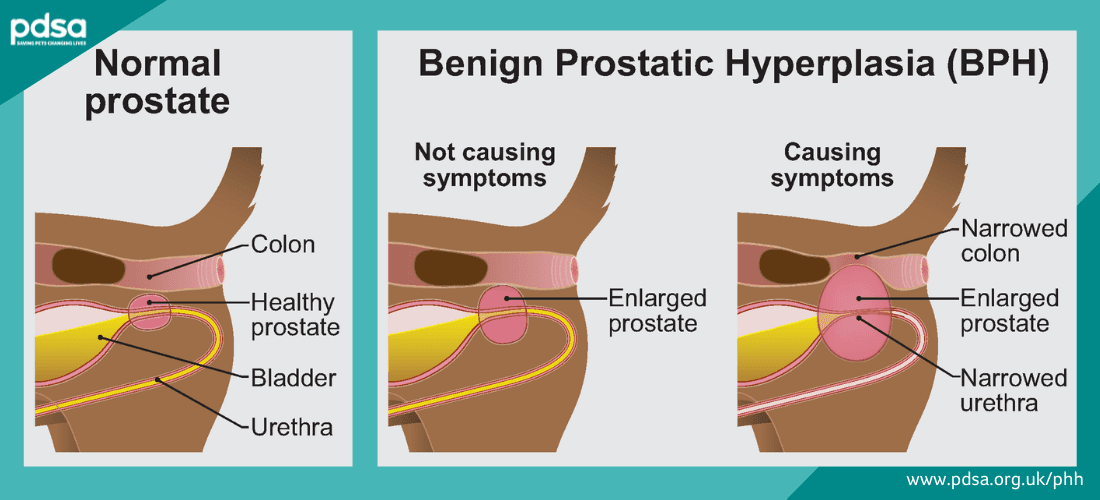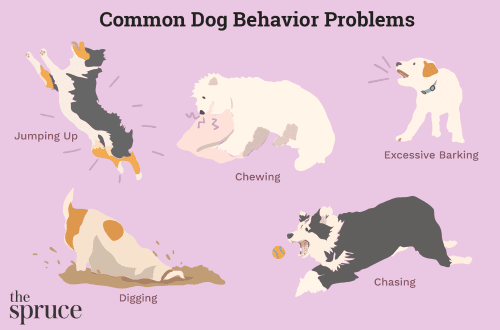
Enlarged Prostate in Dogs: Treatment of Benign Prostatic Hyperplasia
It seems that the problem of an enlarged prostate is only experienced by older men, but any veterinarian will tell you that this is not the case.
Benign prostatic hyperplasia in dogs, often referred to as BPH, is the most common disease affecting the prostate gland in dogs. And it affects the quality of life of the pet.
According to a study published by the Small Animal Division of North American Veterinary Clinics, prostate enlargement occurs in almost all intact males by age 6.
Contents
Cause of benign prostatic hyperplasia in dogs
Normally, the prostate gland in a dog consists of two lobes: one on each side of the urethra, with a small depression between them. The function of the prostate in dogs, like in humans, is to produce fluid that is released into the urethra during ejaculation. It nourishes the spermatozoa and triggers their motility, activating them for fertilization purposes.
A common problem is the abnormal growth of the prostate, which can cause unpleasant urinary side effects. The risk of the disease increases with age, and most often this condition develops in uncastrated males.
The culprit for the unregulated growth of the gland is the main male sex hormone, testosterone. It is often associated with aggression and dominance. Under the influence of testosterone, certain types of cells in the prostate increase in numbers, which is called hyperplasia, and in size, which is called hypertrophy. Over time, this leads to an increase in the size of the prostate gland.

Signs of prostatitis in dogs
Some dogs with BPH do not show any symptoms. Others may have difficulty passing a bowel movement if their prostate is very enlarged and presses on the colon. An enlarged prostate can block a dog’s urethra, leading to straining while urinating.
A sign of benign prostate adenoma in dogs is also a flat ribbon-like stool. Bloody ejaculate or bloody discharge from the penis after mating also indicates this condition, according to the American Kennel Club.
Diagnosis of prostatitis in dogs
Although further diagnosis is required to confirm the cause, prostate enlargement in dogs is most commonly detected by digital rectal examination. An x-ray is also used to diagnose an enlarged prostate.
Your veterinarian may recommend an abdominal ultrasound to confirm that the internal architecture of the prostate is preserved even when the gland is enlarged. A urinalysis and urine culture can be done to rule out a urinary tract infection in a dog.
Rarely, a biopsy is required to distinguish benign prostatic hyperplasia in pets from other prostate conditions such as infection or cancer.
Treatment of prostatitis in dogs
If a pet has an enlarged prostate and is not neutered, neutering is the best treatment. About a month after the procedure, the veterinarian will be able to determine by rectal palpation whether the gland has decreased in the animal. This method of treatment allows you to avoid extensive diagnosis and determine whether the main cause of the increase in the size of the prostate was an adenoma.
If a dog has benign prostatic hyperplasia without any clinical manifestations and the pet is used for mating, observation can be limited.
If owners plan to breed a dog, benign prostatic hyperplasia responds well to treatment with finasteride. This drug blocks the effect of testosterone on the prostate, and after about two to three months, the gland can noticeably decrease in size.
However, if the dog stops taking finasteride, it will relapse. In addition, this drug should not be given to a dog if the owner of the pet is pregnant – even contact with the drug carries certain risks.
Other causes of prostate enlargement in dogs
Prostatitis, or inflammation of the prostate gland, is the second most common cause of prostate enlargement after adenoma and is almost always the result of an infection.
Another possible cause of prostate enlargement is prostate cancer. Although castration eliminates the development of many diseases of the prostate gland, in some cases, neutered dogs also get prostate cancer.
It is important to remember that castration does not increase the risk of prostate cancer in dogs.
How to prevent benign prostatic hyperplasia
Castration is the only effective way to prevent this disease in dogs. Saw palmetto supplements were once reported to be able to prevent or reverse prostate enlargement, but this has since been proven not to be the case.
Although the size of the gland can vary in males, especially if females in estrus are nearby, it is a progressive disease that cannot go away on its own. Antibiotics have also not been shown to be effective in treating BPH.
Supporting a dog’s immune system with a nutritious diet can help prevent infections that develop as a result of prostate disease.
Antioxidants can help stop infections and improve mucosal health. Vitamin C is a natural anti-inflammatory and may help shrink the prostate gland back to its original size.
Left untreated, benign prostatic hyperplasia in a dog can lead to infertility, poor sperm quality, and infections. While this condition is not always easy to spot, dog owners should watch for any warning signs and consult with a veterinarian about treatment options if something goes wrong.
See also:
- Choosing a veterinarian
- Parvovirus in dogs – symptoms and causes of the disease
- Shortness of breath in dogs: when to sound the alarm
- Symptoms of Common Diseases in Older and Older Dogs





